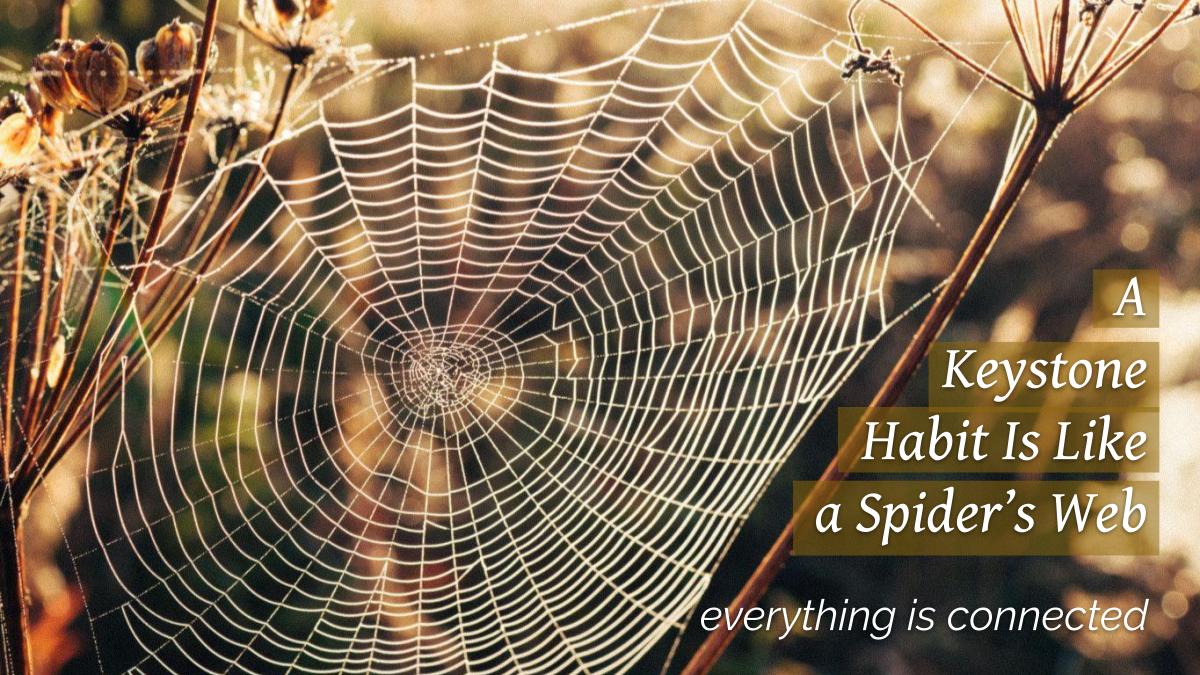A keystone habit is a powerful habit that positively impacts everything you do.
Picture an artist at their desk, the paint splattered surface overflowing with bottles and tubes, pens and sketches. Their creative habit impacts the way they feel—relaxed when painting, frustrated when they can’t—the clothes they wear and how they hold their brushes and coffee mug. It influences the structure of their day—when they paint and when they socialize and rest—and how they see the trivial and the unique in the world. It even impacts the way we view them and their vision. Their keystone habit is to paint every day.
Charles Duhigg, author of The Power of Habit: Why We Do What We Do in Life and Business, and often cited when discussing keystone habits(1), defines keystone habits as “… small changes or habits that people introduce into their routines that unintentionally carry over into other aspects of their lives…”
Duhigg’s ‘small changes’ compliments the idea in James Clear’s book Atomic Habits “… small improvements will add up to something significant.”(2) And that ‘something significant’ is a keystone habit.
This article explains what a keystone habit is, lists some examples, and shares why being helpful is the transformative keystone habit of solving the business problems others can’t.
Develop the Be Helpful Keystone Habit Table of Contents
- What is the Difference Between a Regular Habit and a Keystone Habit?
- Keystone Habit Examples
- Be Helpful: The Keystone Habit that Transforms your Problem Solving Skills
- How to Develop the Be Helpful Keystone Habit
- Recap: The Importance of Keystone Habits
What is the Difference Between a Regular Habit and a Keystone Habit?

A regular habit is a single behaviour we perform again and again. Often without thinking. Like holding the door open for someone or biting our fingernails. I do both—for better and for worse.
A keystone habit is a collection of smaller habits and behaviours that impact areas of our life or business. Being organized is a great example of a keystone habit.
Being organized means you turn up early to meetings, and the meetings you run are effective; your pens and laptop battery are always full; you know what’s on your to do list and when the tasks are due; when someone asks you for a form or a spreadsheet, you can produce them—no fumbling for your disorganized laptop among the shambles of a desk that resembles a free form filing experiment gone terribly wrong.
The keystone habit of being organized results in a high level of self-confidence and positivity because you know what you’re doing and what’s happening around you. Which affects, in a good way, the people you work with and their opinion and level of trust in you.
A keystone habit, and its effects, is like throwing a stone in a pond and watching the ripples spread across the water. Or like a spider’s web with its radials and spirals connecting behaviours and habits that lead back to the centre. To you.
Keystone Habit Examples
There are plenty of examples of keystone habits to choose from. Here are a few personal keystone habits:
- Make your bed in the morning
- Make healthy food choices
- Use your time wisely
- Be personable
- Be organized
- Exercise
- Journal
And here are some business related keystone habits:
- Be helpful
- Be organized
- Be empathetic
- Have an open mind
- Communicate clearly
- Make good decisions
- Follow through on promises made
The beauty of keystone habits is they adapt to meet the needs of the people who use them. There is no definitive list, no wrong or right, no judgement if you prefer to journal rather than exercise.
For example, make your bed in the morning. You could argue this is a throwaway habit that requires no more energy of thought once it’s done. However, Admiral William H. McRaven, in his commencement speech to The University of Texas at Austin’s 2014 graduates(3), saw the act of neatly folding your sheets and blankets as having a bigger purpose:
“If you make your bed every morning, you will have accomplished the first task of the day. It will give you a small sense of pride, and it will encourage you to do another task and another and another. By the end of the day, that one task completed will have turned into many tasks completed. Making your bed will also reinforce the fact that little things in life matter.”
Be Helpful: The Keystone Habit that Transforms your Problem Solving Skills

In this section, we take a deeper dive into the specifics of the Be Helpful keystone habit. I explain what it means to be helpful, the positive behaviours being helpful impacts, and how to develop the Be Helpful keystone habit.
What It Means to Be Helpful
When solving business problems, I have found there is one keystone habit that stands above others: Be Helpful.
The result of being helpful is you are a boon, a godsend, a rock, a pillar, and a plethora of other exemplary traits. In business terms, you are essential to the success of projects, raising team morale, landing the desired client. You are your organization’s unicorn employee.
Being helpful means you are someone others want to work with because you understand their problems, deliver the right solutions when you promised, and care about the outcomes and people involved.
Behaviours The Be Helpful Keystone Habit Improves
The Be Helpful keystone habit is the collection of behaviours that enable you to think and act differently, lead with ethical influence, and ask the right questions. No matter the day of the week or the organizational culture around you.
That means you take a different perspective, encourage your colleagues and clients to trust you, and ask the right questions that get you the answers you need. Day after day.
Just as the artist’s keystone habit of painting shapes their daily behaviours and routines, the Be Helpful keystone habit impacts your leadership behaviours and technical skills.
Leadership traits and soft skills
- How you see yourself and how others see you is the same
- Your messaging has value
- Experiment with new ideas
- Simplify where you can
- Use natural and plain language
- Organize the work to be done
- Look out for others
- Share your experiences
- Your empathy and balance makes you resilient
Technical abilities and hard skills
- Perform accurate business analysis
- Deliver better project management
- Apply practical change management
- Lead with effective team management
Additional Reading in The Become a Better Problem Solver Series
- 4 Tips to Help You Think and Act Differently
- 5 Ways Ethical Leaders Solve Business Problems
- Ask the Right Questions: 2 Questions that Make the Difference
How to Develop the Be Helpful Keystone Habit
When you are helpful, you do less of the negative behaviours, such as perpetuating laborious processes and red tape, and do more of the positive ones, like leading effective meetings. The result is people want to work with you. Because you understand the problems you need to solve, you deliver the right solutions when you promised, and you care about the outcomes and people involved.
Here are two ways you can build your Be Helpful keystone habit and make a difference to problem solving and those around you.
Option #1: Start With the Big Picture and Drill Down to the Details
With this approach, we start at a high level and work our way down to the specific behaviours we want to change or improve. The tool we use is the powerful encourage/barrier questions technique we use for problem solving.
Asking the encourage/barrier questions is much like asking the 5 Whys questions. The intent is to drill down until you reach a point of solid understanding. You ask a question, get an answer, then iterate through by asking the next question with your last answer as the new subject.
What makes the encourage/barrier questions so powerful is the questions help you define what you need to do, and the answers tell you how to do it. Strategy and action in one neat package.
For example:
Q: How can I encourage myself to be helpful?
A: Have people trust my suggestions and timelines.
Q: How can I encourage people to trust my suggestions?
A: Provide real-world examples of how my suggestions have helped other people, be open-minded and flexible in my approach, listen without judgement to feedback on my ideas.
Q: How can I encourage people to trust my timelines?
A: Encourage my team to provide accurate estimates of their work, organize a balanced workload for myself and the team, prioritize the tasks so the right people are working on the right tasks at the right time.
Q: What barriers do I need to remove?
A: My current project tracking process is too cumbersome. I’m in too many meetings and don’t have time to follow up on my own tasks. I’m very attached to my ideas and not always open to change.
The goal is to understand what you need to do, and how to do it, so you become the leader who is easy to work with, trustworthy, and follows through.
Additional reading
For more examples and deeper explanation of the encourage/barrier questions, check out the article on asking the right questions to solve business problems.
Option #2: Pick a Behaviour From the List – Start Small and Grow Big
Another way to develop the Be Helpful keystone habit is to start with a behaviour from the list of Leadership traits and soft skills or improve a technical skill from the Technical abilities and hard skills list.
This way, you begin with a specific behaviour and grow your Be Helpful keystone habit as you improve on more and more of the traits needed to be an exceptional leader.
Leadership traits and soft skills
- How you see yourself and how others see you is the same
- Your messaging has value
- Experiment with new ideas
- Simplify where you can
- Use natural and plain language
- Organize the work to be done
- Look out for others
- Share your experiences
- Your empathy and balance makes you resilient
Technical abilities and hard skills
- Perform accurate business analysis
- Deliver better project management
- Apply practical change management
- Lead with effective team management
For example:
Do your clients or stakeholders become cross-eyed when you use project management terms in your presentations? Do they drift off when you mention sprints, points, epics, scrum master, stakeholder matrix, burndown charts?
They are all valid terms and make sense when used in the right setting. Such as a room full of project managers, scrum masters, and programmers. These project management terms are in context, expected, and therefore, the common language for this group.
When used out of context, to a non-technical audience of admins, office managers, and HR professionals, you risk turning them off and losing them.
The solution? Develop the skill of using natural and plain language.
Why? Because when you talk and write in terms everyone present can relate to, it helps them understand the points you are making. There is no confusion, concern, or intimidation by words they don’t know.
Another benefit of using natural and plain language is the enviable ability to translate between disparate groups. You’re like the tour guide who helps western clients navigate and fall in love with the beauty and bustle of China.
If you can understand business needs and translate those into technical requirements, and translate technical dependencies back into business scenarios, that puts you at the centre of the project. You are the critical liaison between the client and the project team, which makes you a very helpful member of the organization.
Having developed one skill from the lists above, continue to develop another and another. In no time, you have become the person others see as crucial to the success of projects and high-performing teams. You are consistently helpful.
Related Videos
Exceptional Leader Playlist
These eight bite size videos highlight the soft skills exceptional leaders have and how to develop them.
Recap: The Importance of Keystone Habits

When everyone around you is doing the wrong thing, the contrarian view says, “Do the right thing.” Sometimes it’s easy, other times it takes courage, and sometimes, doing it a second time can be harder than the first.
When you keep doing it—the right thing–repeating and adapting as you go, the easier it becomes, and the easier it becomes, the quicker it becomes a habit. Something you do without thinking.
We opened with a quote from James Clear, author of Atomic Habits, and it’s fitting we should close with another(4). “Rather than trying to do something amazing from the beginning, start small and gradually improve.”
Be Helpful is a big habit that touches on lots of behaviours. That’s why it’s a keystone habit. It didn’t become my game changing habit with the click of my fingers or overnight. It took several projects and some experimentation to become an established way of thinking and behaving. And I’m still adjusting and learning as I go.
If I were to boil down the Be Helpful keystone habit to one element, it would be this:
People enjoy working with you because you enjoy helping other people.
Are you ready to build something new and create a better world? Then here are my two questions for you:
- How can you encourage yourself to be helpful?
- What barriers do you need to remove?
Now put your answers into practice and become a better problem solver.
Articles in the Become a Better Problem Solver Series
This is the final article in a four part series on how to solve business problems and takes the strategies highlighted in the previous articles (Think & Act Differently, Use Ethical Leadership, and Ask the Right Questions) and turns them into a powerful and lasting habit.
Footnotes
- Charles Duhigg provides an excellent example of the power of a keystone habit . The international company Alcoa improved its corporate culture, communications systems, performance, quality, and profitability by focusing on one keystone habit. Safety in the workplace.. ↪︎ return
- James Clear’s explanation of the power of small improvements. ↪︎ return
- Admiral William H. McRaven’s commencement speech to The University of Texas at Austin’s 2014 graduates. ↪︎ return

